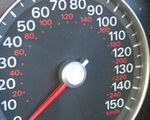 Go to main content
Go to main content
Archive Website of the UK government
Please note that this website has a UK government accesskeys system.
Main menu
Page menu
Travel and transport

Speed limits and speeding

There are different speed limits for cars, vans and towing vehicles on different types of roads. Make sure you know the legal speed limits for your vehicle, the penalties for speeding and when to slow down to suit the road conditions.
National speed limits for different vehicles and types of road
You must not drive faster than the speed limit for the road and your type of vehicle.
A limit of 30 miles per hour (mph) or 48 kilometres per hour (km/h) usually applies to all traffic on all roads with street lighting. This applies unless you see signs showing otherwise.
Table of national speed limits
|
Type of vehicle |
Built-up areas |
Single carriage-ways |
Dual carriage-ways |
Motorways |
|---|---|---|---|---|
|
mph (km/h) |
mph (km/h) |
mph (km/h) |
mph (km/h) |
|
|
Cars & motorcycles |
30 (48) |
60 (96) |
70 (112) |
70 (112) |
|
Cars towing caravans or trailers |
30 (48) |
50 (80) |
60 (96) |
60 (96) |
|
Buses, coaches and minibuses |
30 (48) |
50 (80) |
60 (96) |
70 (112) |
|
Goods vehicles |
30 (48) |
50 (80) |
60 (96) |
70 (112) |
|
Goods vehicles |
30 (48) |
40 (64) |
50 (80) |
60 (96) |
Vans and ‘car-derived’ vans
Most vans are under 7.5 tonnes laden (loaded) weight and must follow the speed limits for goods vehicles of the same weight.
‘Car-derived’ vans weigh no more than 2 tonnes when loaded and are based on car designs, for example:
- Ford Fiesta van
- Vauxhall Astra van
- Fiat Punto van
- Peugot 207 van
- Renault Clio van
Traffic signs for speed limits
See 'Warning, regulatory and speed limit signs' and 'Know your traffic signs' for:
- examples of the traffic signs used to show speed limits
- information on when you’ll see them on different roads
Locally set speed limits
Local councils may set their own speed limits in areas where there is a particular need. For example, there could be a:
- 20 mph zone in a built-up area near a school
- 50 mph (rather than 60 mph) speed limit on a stretch of road with sharp bends
Local limits must be clearly signed.
Speeding fines and penalty points
Driving over the speed limit (whether national or locally set) is against the law. The minimum penalty for speeding is a £60 fine and three penalty points added to your licence.
If you already have a certain number of points on your licence, you won’t be offered a fine and you’ll have to go to court.
The police enforce the speed limit and may use:
- fixed or mobile speed cameras
- average speed cameras (which measure a vehicle's average speed between two points)
See ‘Cameras on motorways and trunk roads’ for more information about where speed cameras are used.
Drive to suit the conditions, not just the speed limit
THINK! It's 30 for a reason

The difference of a few miles per hour can mean the difference between life and death
Many accidents happen when drivers are within the speed limit but driving too fast for the road conditions on the road.
Use your judgement and know when to slow down. Think carefully about the speed at which you:
- approach a bend in the road
- cross a roundabout
- approach a junction
- can safely overtake
- drive past or through roadworks
- drive in bad weather
Be particularly careful on unlit roads at night, where oncoming headlights can dazzle you.
Know your Highway Code
Speed limits are set out in the Highway Code. For information on safe stopping distances for different speeds and how to brake safely, follow the link below.
In this section...
Additional links
Your eyes will give you away

Find out how drugs impair your driving and how the police can spot drug drivers
THINK! It's 30 for a reason

The difference of a few miles per hour can mean the difference between life and death
